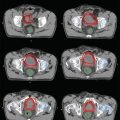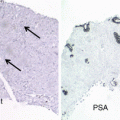© Springer International Publishing AG 2017
Gokhan Ozyigit and Ugur Selek (eds.)Principles and Practice of Urooncologyhttps://doi.org/10.1007/978-3-319-56114-1_66. Targeted Therapies and Immunotherapy in Bladder Cancer
(1)
Department of Medical Oncology, Ankara Yıldırım Beyazıt University, Ankara, Turkey
(2)
Department of Medical Oncology, Hacettepe University Cancer Institute, Ankara, Turkey
Abstract
Cisplatin-based combination chemotherapy is still the standard first-line regimen for the treatment of metastatic urothelial carcinoma. Although the efficacy of targeted therapies was shown in most of the solid tumors, no targeted agent was approved until now in bladder cancer. Due to the preliminary phase II results of gemcitabine, cisplatin plus bevacizumab demonstrated promising objective response rate, overall survival, and progression-free survival in the first-line treatment of metastatic bladder cancer; a phase III is ongoing. The major advances in understanding the genetic background of urothelial tumors open up a new therapeutic area. Although the application of checkpoint inhibitors in bladder cancer is in its starting phase, the available results suggest that patients with metastatic disease and positive programmed death-ligand-1 (PD-L1 ) expression will derive the highest clinical benefit. Atezolizumab, an anti-PD-L1 monoclonal antibody, was approved by the Food and Drug Administration for the treatment of patients with locally advanced or metastatic urothelial carcinoma whose disease progressed after previous platinum-based chemotherapy. Both pembrolizumab and nivolumab , anti-PD-1 monoclonal antibodies, demonstrated antitumor activity with tolerable safety in patients with recurrent or metastatic urothelial cancer patients. Combination therapies to treat bladder cancer, involving cytotoxic chemotherapy, antiangiogenic agents, and immune checkpoint inhibitors, are currently ongoing.
Keywords
Bladder cancerImmunotherapyTargeted therapies6.1 Introduction
An estimated 76,960 new cases (58,950 men, 18,010 women) of urinary bladder will be diagnosed in the United States in 2016. Bladder cancer is the fourth most common diagnosed cancer in men and is more than three times prevalent than women [1]. Transitional cell carcinoma is the most predominant histologic type, and it accounts for 90% of all bladder cancers. Although most of the patients present with noninvasive bladder cancer, approximately 25% of the patients develop distant metastases either at the time of diagnosis or later [2].
Systemic chemotherapy is the cornerstone of treatment for unresectable or metastatic urothelial carcinomas. The first-line standard of care in metastatic bladder cancer is platinum-based combination chemotherapy. Gemcitabine plus cisplatin (GC) combination or methotrexate, vinblastine, adriamycin, and cisplatin (MVAC ) regimens are standard regimens in unresectable or metastatic urothelial carcinomas, if patients fit enough to tolerate cisplatin [2, 3]. MVAC is one of the standard first-line options based on the results of two randomized clinical trials [4, 5]. In a prospective randomized trial, 110 patients with metastatic urothelial tumor were randomly assigned to MVAC or cisplatin, cyclophosphamide, plus adriamycin combination chemotherapy regimens [4]. In this study, the objective response rate (ORR) (65 vs 46%; P < 0.05) and overall survival (OS) (median, 48.3 weeks vs 36.1 weeks) were significantly higher in patients treated with MVAC regimen. In another randomized trial of 269 patients with advanced urothelial carcinoma who were randomly assigned to treatment with either MVAC or single-agent cisplatin, MVAC regimen is associated with significantly higher ORR (39 vs 12%; P < 0.0001), higher median progression-free survival (PFS) (10.0 vs 4.3 months), and higher median OS (12.5 vs 8.2 months; P = 0.0002) compared to the single-agent cisplatin arm [5]. In MVAC regimen, grade 3 or 4 leukopenia, mucositis, granulocytopenic fever, and drug-related mortality were more common compared to cisplatin single-agent arm.
In a randomized phase III trial in which 405 patients were randomly assigned to either GC or MVAC , similar ORR (GC, 49%; MVAC, 46%), similar PFS (7.7 months in GC and 8.3 months in MVAC), and similar OS (14.0 months in GC, 15.2 months in MVAC, HR, 1.09; 95% confidence interval (CI), 0.88 to 1.34, P = 0.66) results were reported [2, 6]. In MVAC group, compared to GC group, patients had more grade 3/4 neutropenia (82 vs 71%), neutropenic fever (14 vs 2%), neutropenic sepsis (12 vs 1%), mucositis (22 vs 1%), and alopecia (55 vs 11%). Until now, no significant OS benefit was achieved with triplet regimens or sequential combination regimens in the first-line treatment of patients with metastatic urothelial carcinoma [7, 8]. Due to high tolerability and less toxicity compared to MVAC, these results strengthen the role of GC as a standard first-line regimen in patients with locally advanced and metastatic bladder cancer.
Cisplatin-based combinations are the standard first-line regimens, but carboplatin-based chemotherapy is frequently substituted due to ineligible for cisplatin or to improve tolerability. Although direct comparative effectiveness of cisplatin and carboplatin is lacking in randomized trials, a total of 286 patients with metastatic urothelial carcinoma from four randomized trials were analyzed in a meta-analysis [9]. Although PFS and OS results were inadequate to compare cisplatin- and carboplatin-based regimens, cisplatin-based chemotherapy was significantly associated with higher rates of complete response (RR = 3.54; 95% CI 1.48–8.49; P = 0.005) and ORR (RR = 1.34; 95% CI 1.04–1.71; P = 0.02). Thus cisplatin-based combinations are associated with higher response rates.
In the randomized phase II/III EORTC 30986 trial, 238 chemotherapy-naïve patients unfit for cisplatin-based chemotherapy (glomerular filtration rate <60 but >30 mL/min) and/or a poor performance status (ECOG ≥2) were randomly assigned to treatment with carboplatin and gemcitabine or methotrexate, carboplatin, and vinblastine regimens [10]. There were no significant differences in OS (9.3 vs 8.1 months, respectively, P = 0.64), PFS (6 vs 4 months, respectively), and ORR (41 vs 30%, respectively) between the two treatment groups, but the incidence of severe acute toxicities was higher for patients treated with methotrexate, carboplatin, and vinblastine regimen. Thus gemcitabine plus carboplatin can be the first-line standard regimen for patients with advanced urothelial carcinoma unfit for cisplatin-based chemotherapy.
A number of chemotherapy drugs have single-agent activity in patients with metastatic urothelial carcinoma in previously treated patients such as platinum compounds, gemcitabine, vinblastine, doxorubicin, epirubicin, methotrexate, paclitaxel, docetaxel, and ifosfamide mostly dependent phase II trials [11]. Unfortunately, responses to single-agent chemotherapy are generally of short duration with no consistent improvement in survival. Vinflunine, a novel third-generation microtubule-inhibitor vinca alkaloid, is the only drug that tested in a valid randomized phase III trial in patients progressing after first-line treatment with platinum-containing combination chemotherapy [12, 13]. In this study, a total of 370 patients with advanced transitional cell carcinoma of urothelial tract who progressed after first-line platinum-containing regimen were randomly assigned to vinflunine plus best supportive care or best supportive care. Overall response rate, disease control, and PFS were all statistically significant favoring vinflunine plus best supportive care (P = 0.006, P = 0.002, and P = 0.001, respectively). Although, in the intent-to-treat population, no significant OS difference (6.9 vs 4.6 months, P = 0.287) was achieved, after adjusting for prognostic factors (HR = 0.77; 95% CI, 0.61–0.98, P = 0.036) and in the eligible population (n = 357), the median OS was significantly longer in vinflunine plus best supportive care than best supportive care group alone (6.9 vs 4.3 months, respectively, P = 0.040). This trial reached the highest level of evidence ever reported for second-line treatment. In Europe, vinflunine is the only approved chemotherapy drug in this setting, but there is no standard accepted second-line regimen all over the world.
Despite ORR, PFS, and OS rates were improved with cisplatin-based combinations in patients with metastatic urothelial carcinoma, most of the patients progressed within 6–8 months, and median survival was not more than 15 months according to the previous randomized trials. The aim of this chapter is to review the results of new targeted therapies and immunotherapy in unresectable or metastatic bladder cancer.
6.2 Targeted Agents
Molecular analysis identified genetic and epigenetic alterations in high-grade urothelial carcinomas, and about 60% of these alterations can be targeted by drugs already approved for use in other indications or in clinical trials [14]. Previous studies showed the amplification of FGFR1, CCND1, and MDM2. Alterations in regulators of G1-S cell cycle progression, such as TP53 and RB, FGFR3 mutations and translocations, and PTEN deletions can also occur. In addition to recurrent mutations in the receptor tyrosine kinases, RAS/RAF, PI3K, AKT, and mammalian target of rapamycin (mTOR) pathways were identified [15, 16]. The RAS signaling pathway appears to have a major role in the development of low-grade, noninvasive lesions; 30–40% are characterized by activating mutations in the HRAS gene . Molecular analyses identified kinase-activating fibroblast growth factor receptors-3 (FGFR3) gene fusions in up to 70% of urothelial cancers, an upstream tyrosine kinase receptor involved in cellular proliferation and angiogenesis [17].
In the Cancer Genome Atlas project , an integrated analysis of 131 urothelial carcinomas was investigated to provide a comprehensive landscape of molecular alterations [14]. In this comprehensive analysis, potential therapeutic targets were identified in 69% of the tumors, 42% of urothelial carcinomas had genomic alterations targets phosphatidylinositol-3-OH kinase/AKT/mTOR pathway, and 45% had genomic alterations targets including ERBB2 RTK/MAPK pathway.
Although FGFR3 mutations are associated with cellular proliferation, differentiation, migration, and angiogenesis, FGFR mutations are a common feature of low-grade noninvasive papillary urothelial bladder cancer; it rarely occurs in high-grade invasive bladder cancer. FGFR3 mutations are a common feature in noninvasive urothelial bladder cancer and occur at a lower frequency (12–15%) in high-grade metastatic urothelial carcinomas [14]. In contrary to FGFR3 mutations, FGFR1 overexpression was observed in all stages of bladder carcinomas [18]. Tyrosine kinase inhibitors, monoclonal anti-FGFR antibodies, and FGF-trapping molecules that targeted FGFR are currently under development. In a phase II trial in patients with progressive advanced urothelial carcinoma, dovitinib, a FGFR3 included broad tyrosine kinase inhibitor, had very limited activity in both FGFR3-mutated and FGFR3 wild-type groups [19]. Phase I and II trials of BGJ398, a pan-inhibitor of FGFR, are still currently ongoing.
In the Cancer Genome Atlas project , 42% of urothelial carcinomas had genomic alterations targets phosphatidylinositol-3-OH kinase/AKT/mTOR pathway [14]. This pathway is an essential pathway involved in cell growth, cell survival, and cell metabolism. The role of buparlisib (BKM120), an oral PI3K inhibitor, is currently investigated in a phase II clinical trial in the second-line setting for patients with metastatic urothelial carcinoma. In a phase II study, 37 patients with advanced urothelial carcinoma who progressed after platinum-based therapy were treated with everolimus, an mTOR inhibitor, 10 mg/day until progressive disease or unacceptable toxicity [20]. The primary endpoint disease control rate was 27% at 8 weeks. In a whole-genome sequencing analysis of 109 patients with metastatic bladder cancer treated with everolimus, tuberous sclerosis complex 1 (TSC1) mutations was found in 8% of tumors and correlated with everolimus sensitivity [21].
The human epidermal growth factor receptor-2 (HER2) status is important for the management of early and metastatic breast cancer and for the metastatic gastric cancer, for both prognosis and prediction of the response to targeted therapies [22, 23]. Approximately 15–25% of all breast cancers and 20% of all metastatic gastric cancers are HER2 positive and display gene amplification or HER2 overexpression [23–26]. Accurate determination of HER2 status may be of prognostic and predictive value for the targeted therapies. In invasive urothelial bladder carcinomas, the true incidence of HER2 overexpression and/or amplification remains uncertain ranging from 23 to 80% for overexpression and from 0 to 32% for amplification [27]. Lae and colleagues investigated 1005 primary invasive urothelial bladder carcinomas for HER2 evaluation and reported that HER2 overexpression was found in 9.2% of tumor samples and 5.1% of invasive bladder carcinomas had a HER2 gene amplification by FISH confirmation [27]. HER2-positive patients with metastatic urothelial carcinomas had more metastatic sites and visceral metastasis than did HER2-negative patients [28, 29]. Several clinical trials are currently ongoing to identify potential candidates for targeted therapy in locally advanced or metastatic bladder cancer patients with HER2 overexpression. A single-arm phase II study evaluating trastuzumab in combination with paclitaxel, gemcitabine, and carboplatin in 44 patients with HER2-positive urothelial carcinoma showed a 70%, 9.3, and 14.1 months response rate, median time to progression, and survival, respectively [28]. In another phase II trial, patients with advanced or metastatic urothelial carcinoma overexpressing HER2 were randomly assigned to gemcitabine + platinum combination with or without trastuzumab [30]. In this trial, among 563 screened patients, 75 (13.3%) were HER2 positive (IHC 2+/3+ and FISH+). In both arms, no significant difference was found in terms of PFS, ORR, and OS. In a single-arm, prospective phase II study, 59 patients with locally advanced or metastatic transitional cell carcinoma were treated with second-line lapatinib, an EGFR and a HER2 inhibitor, and the primary endpoint ORR >10% was observed only in one (1.7%) patient [31]. The median OS was significantly prolonged in patients with tumors that overexpressed EGFR and/or HER2 (P = 0.0001). In a phase II/III, double-blind, randomized trial, 348 patients with HER1-/HER2-positive metastatic bladder cancer were randomly assigned to maintenance lapatinib versus placebo after first-line chemotherapy, and it shows that lapatinib maintenance did not improve the primary outcome PFS (4.6 months in lapatinib arm, 5.3 months in placebo, HR: 1.04, P = 0.77) [32]. Similarly, OS and ORR did not significantly differ with maintenance lapatinib in HER1-/HER2-positive metastatic bladder cancer. Despite promising therapeutic targets, EGFR inhibitors have not reached their goal in the clinic with disappointing activity in the treatment of urothelial carcinoma. Although previous trials targeting HER2 were inconclusive in metastatic urothelial carcinoma, new agents targeting HER2 may be more effective. Trastuzumab emtansine (T-DM1) has promising antitumor effects in preclinical models of HER2-positive bladder cancer models [33].
In a phase II randomized trial to determine the efficacy of EGFR inhibition in urothelial cancers, 39 patients with chemotherapy-refractory metastatic urothelial cancer who have progressed after one previous treatment were randomly assigned to cetuximab with and without paclitaxel [34]. Although the single-agent cetuximab arm closed early due to 82% of first 11 patients progressed by 8 weeks, the combination arm showed 25% ORR with median 10.5 months OS. Cetuximab plus paclitaxel combination showed promising activity in the second-line treatment of patients with metastatic urothelial carcinoma.
Several antiangiogenic drugs have been approved in a different tumor types, but most of the majority of such agents failed to demonstrate clinical activity in advanced-stage urothelial carcinoma, either in monotherapy or in combination with cytotoxic chemotherapy [35, 36]. In a single-arm phase II study, chemotherapy-naïve patients with metastatic or unresectable urothelial carcinoma were treated with gemcitabine, cisplatin, plus bevacizumab combination as first line [37]. A total 43 patients were treated with combination, and the ORR was 72%, PFS was 8.2 months, and OS was 19.1 months. Due to gemcitabine, cisplatin plus bevacizumab demonstrated promising OS and PFS; a phase III is ongoing.
6.3 Immunotherapy
Based on the immunogenic properties of some solid tumors, immunotherapy was launched as one of the treatment modalities in cancer therapy many decades ago. Bladder cancer is a highly immunogenic cancer type due to high mutational load which is associated with triggering the immune response as tumor antigens. Intravesical bacillus Calmette-Guérin (BCG) is the first Food and Drug Administration (FDA)-approved immunotherapy that significantly reduced the risk of recurrence in patients with noninvasive urothelial bladder cancer by stimulating immune response and thus is a standard treatment for non-muscle invasive bladder cancer [38, 39]. A systematic literature review of 13 randomized controlled trials (RCTs) with 2548 patients examined the role of receiving intravesical chemotherapy immediately in patients with non-muscle invasive bladder cancer [40]. In this systematic review, recurrence-free interval prolonged by 38% (HR: 0.62; 95% CI, 0.50–0.77; p < 0.001), and early recurrences were 12% less compared to control group population.
Immune system is well balanced between co-activator and co-inhibitor signals. Immune checkpoints are very important step for regulating host immune system by blocking immune response, preventing normal tissue damage, and autoimmunity. Programmed cell death protein 1 (PD-1), programmed cell death protein ligand 1 (PD-L1 ), and cytotoxic T-lymphocyte-associated protein 4 (CTLA-4) are the main components of immune checkpoints [41]. Checkpoint inhibitors that targeted to CTLA-4 and PD-1 have been studied more extensively in solid tumors and demonstrated significant response with these agents.
Cancer cell, which have abnormal antigen expression due to many genetics and epigenetic abnormalities, can be detected and eradicated by host immune system. T cells are chief elements of the host immunity. Immune response is initiated by the recognition of tumor-specific antigen presented by the major histocompatibility complex (MHC) on the surface of antigen-presenting cells (dendritic cells, macrophage, etc.). After interaction between MHC and T-cell receptor (TCR), several co-stimulators are secreted for enhancing to immune response. Consequently, innate and adaptive immune systems are activated, and active immune systems detect and eradicate cancer cells before tumors become clinically apparent, also called immune surveillance. However, immune system is tightly regulated by co-stimulatory and inhibitory molecules; therefore, balance between stimulatory and inhibitory molecules are crucial to maintain immune response. In the physiologic condition, co-inhibitor molecules can avoid excessive immune response and, consequently, prevent normal tissue damaged and autoimmunity.
Stay updated, free articles. Join our Telegram channel

Full access? Get Clinical Tree








